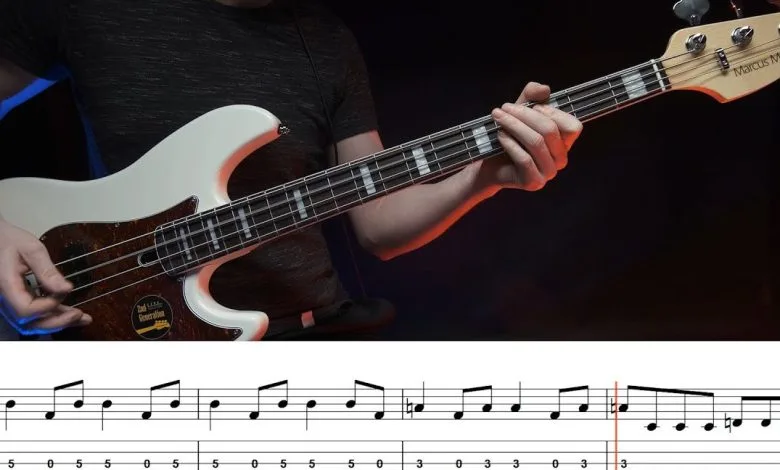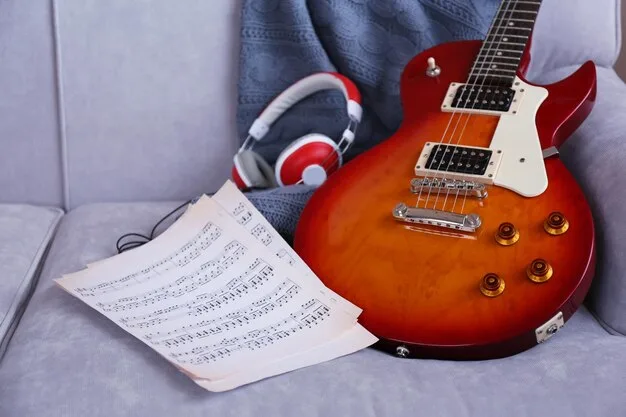Have you ever looked at a piece of bass guitar sheet music and felt overwhelmed? Worry not, my friend! In this guide, I’ll show you the ropes on how to read bass guitar sheet music like a pro.
As someone who has been studying and performing music for years, I know that reading sheet music can be a daunting task. But don’t let it scare you away from unleashing your inner rockstar!
In this article, we’ll discuss everything from the basic elements of sheet music to more advanced techniques like key signatures and time signatures. By the end of it, you’ll have all the tools you need to confidently read any piece of bass guitar sheet music that comes your way.
So grab your bass and let’s dive into this beginner’s guide on how to read bass guitar sheet music with ease!
So, how to read bass guitar sheet music?
Learning how to read bass guitar sheet music is an essential skill for any beginner looking to become a pro. Sheet music allows you to accurately play and understand the notes, rhythms, and other musical elements in a song.
To start with, it’s important to understand that bass guitar sheet music uses the same basic notation as regular sheet music. This includes the staff, which consists of five lines and four spaces where musical notes are placed. The higher pitches are located towards the top of the staff while lower pitches are towards the bottom.
The first step in reading bass guitar sheet music is learning how to identify notes on the staff. Each line or space represents a different note on your instrument. For example, the bottom line represents E, followed by G, B, D and F on each subsequent line going upwards.
Next, you’ll need to learn about time signatures and rhythm notation. Time signatures tell you how many beats there are per measure (the space between two vertical bar lines). Rhythm notation indicates how long each note should be held for based on its shape – whole notes being held for four beats while half notes are held for two beats.
Other important symbols found in bass guitar sheet music include rests (silences), sharps (#) and flats (b). These symbols affect both pitch and duration of a note or rest within a piece of music.
Once you have a good understanding of these basics, it’s time to practice reading actual songs from sheet music. Start with simple melodies or familiar tunes before moving onto more complex pieces. As with any new skill, consistent practice is key to mastering reading bass guitar sheet music like a pro.
In conclusion, learning how to read bass guitar sheet music may seem daunting at first but with patience and practice it can become second nature. Not only will this skill enhance your playing abilities but also open up endless possibilities for creating your own unique sound as a musician.
Understanding the Basics of Sheet Music for Bass Guitar
When you look at a piece of sheet music for bass guitar, it might seem like a jumble of notes and symbols at first. However, once you grasp the basics, it becomes much clearer! The staff, made up of five lines and four spaces, is where we find our musical notes. Each line or space represents a different pitch. For bass guitarists, the bass clef is used primarily; this tells us the lower pitches that the instrument produces. Notes on the second line from the bottom are usually an “A,” while spaces spell out “ACE” as you move up!
To read sheet music effectively, it’s also essential to understand rhythms and timing. The shapes and flags on each note indicate how long they should be held. You’ll see whole notes that last four beats and half notes lasting two beats—it’s like giving life to each note!
As you get more comfortable with these fundamentals—like rests that create pauses in music—you’ll start to recognize patterns and phrases within songs. This understanding allows players not just to follow along but truly express themselves through their playing style! With practice, reading sheet music can become as natural as breathing for any aspiring bassist!
Read also: is johnny depp a good guitar player
Decoding the Staff, Clefs and Notes in Bass Guitar Sheet Music
Understanding bass guitar sheet music can feel a bit like unlocking a secret code. At first glance, you might see a jumble of lines and symbols. But when you take a closer look, it becomes clearer. The staff, which is made up of five horizontal lines, serves as the playground for musical notes. Each line and space represents specific pitches that correspond to the sounds your bass guitar will make. For instance, on the bass clef—often referred to as the F clef because it marks where the note F sits—you’ll find that notes on different positions change how high or low they sound.
When reading these notes, it’s essential to remember their names: E, G, B, D, and F for the lines and A, C, E, and G for the spaces in between. You can think of them like stepping stones across a stream; each one leads you further into understanding music. As you practice with sheet music, try identifying patterns or familiar melodies that utilize these notes! Before long, you’ll be able to read this language effortlessly while playing along with your favorite songs.
Keep your eyes peeled for other notations too—like dynamics (which show how loudly or softly to play), time signatures (indicating rhythm), and various articulations—to enhance your performance even more!

Navigating Key Signatures and Time Signatures on Bass Guitar Sheets
When you pick up a bass guitar, one of the first things you’ll notice is how crucial understanding key signatures and time signatures is for playing music. Key signatures tell you which notes will be sharp or flat throughout a piece, helping your fingers find their way on the fretboard with ease. For instance, if you’re in the key of C major, there are no sharps or flats to worry about, making it quite friendly for beginners. However, if you venture into G major with its single sharp (F#), suddenly your ears will perk up as that note changes the atmosphere of the melody. Recognizing these subtle shifts allows players to capture the intended emotions behind songs and helps create that beautiful harmony with other musicians.
Now let’s talk about time signatures—these dictate how music flows and keeps everything organized. A common time signature like 4/4 means there are four beats in each measure with a quarter note getting one beat. Imagine tapping your foot: one, two, three, four. But when you encounter something quirky like 6/8, it feels more fluid because it’s grouped differently; think of it as two sets of triplets rolling along smoothly together! Understanding these concepts not only aids in reading bass sheets but also enhances your ability to play along rhythmically and confidently within any ensemble setting.
Learning how to recognize these patterns opens doors to countless musical possibilities!
Interpreting Symbols, Markings, and Notations in Bass Guitar Music
When diving into the world of bass guitar music, it’s fascinating to see how symbols, markings, and notations play a crucial role in shaping a musician’s experience. These elements are like a secret language that helps players understand what to do with their instrument. For instance, standard notation indicates pitch and rhythm, while tablature shows exactly where to place fingers on the fretboard. This combination allows musicians to communicate ideas effectively, guiding them through complex pieces or simple grooves alike.
Additionally, various markings can provide insights about the style and feel of a piece.
- Phrasing marks, like slurs and staccato dots, tell you how smoothly or sharply to play notes.
- Dynamics symbols indicate volume changes—whether it should be soft (piano) or loud (forte).
- The use of fingerings helps navigate tricky sections by suggesting specific fingers for certain frets.
Interpreting these details enriches performance; they deepen understanding of musical expression. By learning this visual shorthand, bassists unlock new levels of creativity while also connecting more profoundly with the music they love. Embracing these symbols not only enhances technical skills but also invites personal interpretation, making every performance unique.
You may also like: Why are Taylor guitars so easy to play
Conclusion: Mastering the Art of Reading Bass Guitar Sheet Music
Reading bass guitar sheet music can feel like learning a new language. The notes and symbols on the page tell a story that comes alive when you play. To start, it helps to understand the staff, which consists of five lines and four spaces where notes are placed. Each note corresponds to a specific pitch; for instance, an “A” is found in the second space from the bottom, while “E” sits on the first line below. Comprehending these basics allows you to visualize your instrument’s fretboard better, making it easier to find where those notes live on your bass.
As you dive deeper into reading music, you’ll encounter other important elements like time signatures, rests, and dynamics. Time signatures indicate how many beats are in each measure; for example, 4/4 means there are four beats per measure—great for most popular songs! Rests signal pauses in playing, allowing melodies to breathe and creating tension in your music. Understanding dynamics will guide how loudly or softly you should play certain passages. By mastering these aspects of sheet music reading, you’re not just following instructions; you’re becoming part of an expressive journey with every pluck of the string!

